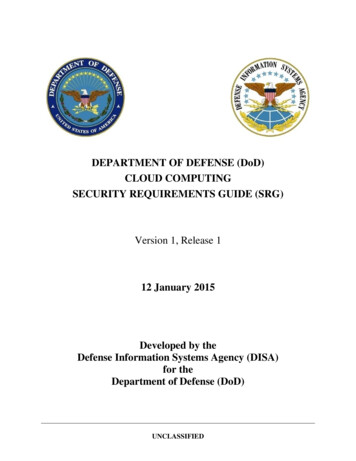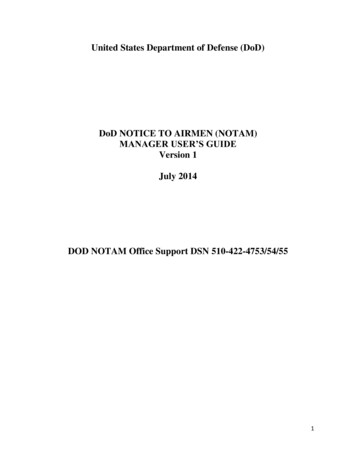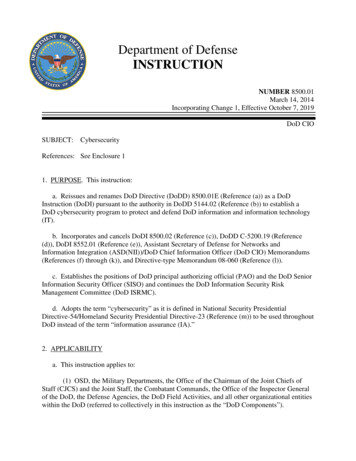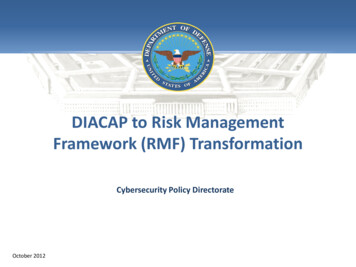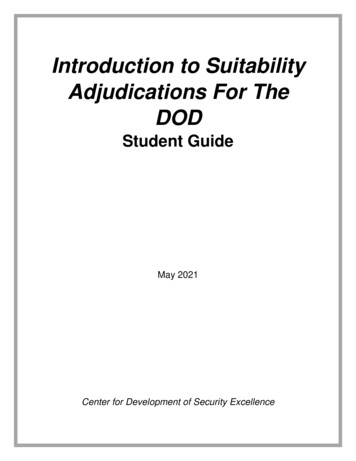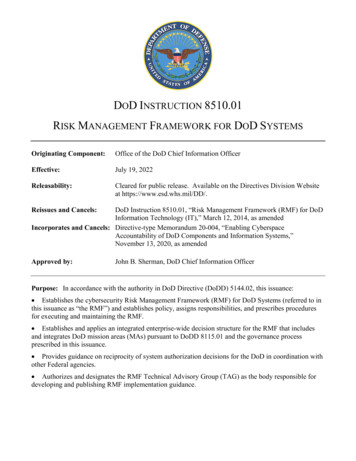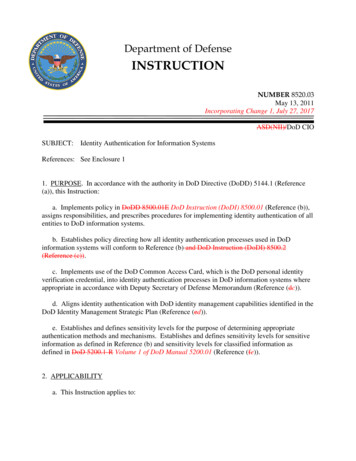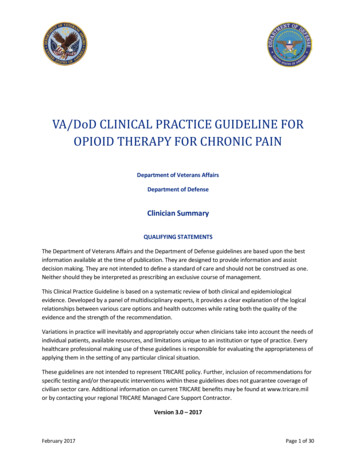
Transcription
VA/DoD CLINICAL PRACTICE GUIDELINE FOROPIOID THERAPY FOR CHRONIC PAINDepartment of Veterans AffairsDepartment of DefenseClinician SummaryQUALIFYING STATEMENTSThe Department of Veterans Affairs and the Department of Defense guidelines are based upon the bestinformation available at the time of publication. They are designed to provide information and assistdecision making. They are not intended to define a standard of care and should not be construed as one.Neither should they be interpreted as prescribing an exclusive course of management.This Clinical Practice Guideline is based on a systematic review of both clinical and epidemiologicalevidence. Developed by a panel of multidisciplinary experts, it provides a clear explanation of the logicalrelationships between various care options and health outcomes while rating both the quality of theevidence and the strength of the recommendation.Variations in practice will inevitably and appropriately occur when clinicians take into account the needs ofindividual patients, available resources, and limitations unique to an institution or type of practice. Everyhealthcare professional making use of these guidelines is responsible for evaluating the appropriateness ofapplying them in the setting of any particular clinical situation.These guidelines are not intended to represent TRICARE policy. Further, inclusion of recommendations forspecific testing and/or therapeutic interventions within these guidelines does not guarantee coverage ofcivilian sector care. Additional information on current TRICARE benefits may be found at www.tricare.milor by contacting your regional TRICARE Managed Care Support Contractor.Version 3.0 – 2017February 2017Page 1 of 30
VA/DoD Clinical Practice Guideline for Opioid Therapy for Chronic Pain – Clinician SummaryTable of ContentsI.Introduction. 4II.How to Use the Clinical Practice Guideline . 4III. Recommendations . 6IV. Algorithm . 9V.A.Module A: Determination of Appropriateness for Opioid Therapy . 10B.Module B: Treatment with Opioid Therapy. 11C.Module C: Tapering or Discontinuation of Opioid Therapy . 12D.Module D: Patients Currently on Opioid Therapy . 13Scope of the CPG. 14VI. Guideline Work Group . 15VII. Patient-centered Care . 16VIII. Shared Decision Making . 16IX. Chronic Pain Treatment Options . 17X.A.Known Risks and Lack of Benefit of Opioid Therapy for Chronic Pain . 17B.Preferred Chronic Pain Treatment Options . 17C.Patient Populations at Additional Risk for Adverse Events with Long-term Opioid Therapy . 18Initiation of Long-term Opioid Therapy . 18A.Duration of Opioid Therapy. 18B.Dose of Opioid Therapy . 18C.Selection of Opioid Therapy . 19XI. Risk Mitigation Strategies for Long-term Opioid Therapy . 19A.Written Informed Consent and Opioid Treatment Agreements . 20B.Urine Drug Testing . 20C.State Prescription Drug Monitoring Programs . 20D.Monitoring for Overdose Potential and Suicidality . 21E.Prescribing of Naloxone Rescue and Accompanying Education . 21F.Follow-up . 21XII. Tapering . 21XIII. Diagnosis and Treatment of Opioid Use Disorder . 23XIV. Clinical Pearls for Prescribing Opioids. 24February 2017Page 2 of 30
VA/DoD Clinical Practice Guideline for Opioid Therapy for Chronic Pain – Clinician SummaryXV. Additional Resources . 24XVI.VA Signature Informed Consent .25References . 30February 2017Page 3 of 30
VA/DoD Clinical Practice Guideline for Opioid Therapy for Chronic Pain – Clinician SummaryI.IntroductionThe Department of Veterans Affairs (VA) and Department of Defense (DoD) Evidence-Based Practice WorkGroup (EBPWG) was established and first chartered in 2004, with a mission to advise the “ HealthExecutive Council on the use of clinical and epidemiological evidence to improve the health of thepopulation across the Veterans Health Administration and Military Health System,” by facilitating thedevelopment of clinical practice guidelines (CPGs) for the VA and DoD populations.[1] The VA/DoD CPG isintended to provide healthcare providers with a framework by which to evaluate, treat, and manage theindividual needs and preferences of patients with chronic pain who are on or being considered for longterm opioid therapy (LOT).In 2010, the VA and DoD published the Clinical Practice Guideline for Management of Opioid Therapy forChronic Pain (2010 OT CPG), which was based on evidence reviewed through March 2009. Since therelease of that guideline, there has been growing recognition of an epidemic of opioid misuse and opioiduse disorder (OUD) in America, including among America’s Veterans. At the same time, there is a mountingbody of research expanding our knowledge and understanding of the troublesome effects of LOT.Consequently, a recommendation to update the 2010 OT CPG was initiated in 2015. The updated CPG,titled Clinical Practice Guideline for Opioid Therapy for Chronic Pain (OT CPG), includes objective, evidencebased information on the management of chronic pain. It is intended to assist healthcare providers in allaspects of patient care, including, but not limited to, diagnosis, treatment, and follow-up. The system-widegoal of the guideline is to improve the patient’s health and well-being by providing evidence-basedguidance to providers who are taking care of patients on or being considered for LOT. The expectedoutcome of successful implementation of the guideline is to:II. Assess the patient’s condition and determine, in collaboration with the patient and his or hercare team, the best treatment methods Optimize the patient’s health outcomes and function and improve quality of life Minimize preventable complications and morbidity Emphasize the use of patient-centered careHow to Use the Clinical Practice GuidelineThe VA/DoD OT CPG can be used in a variety of ways. It can be used by general clinicians or specialists tostudy and consider the latest information on OT and how and whether to incorporate that information orrecommendations into their practice. It can be used to provide specific information to guide a patientencounter, such as looking up the dosing of a medication used less frequently or the meaning of the urinedrug test (UDT) result. The section on tapering and its accompanying appendix (in the full text OT CPG) canbe used to assist in the development of a framework for guiding an individualized, informed discussionwhen tapering is being considered. Patients can examine the guideline to educate themselves and betterunderstand their care. A healthcare system can use the CPG to assure that its clinicians and patients havethe resources available to compassionately, effectively, and safely evaluate and deliver LOT in a timely,culturally sensitive manner. The guideline can also be used to suggest specific education for identifiedgaps.February 2017Page 4 of 30
VA/DoD Clinical Practice Guideline for Opioid Therapy for Chronic Pain – Clinician SummaryThe guideline is not intended as a standard of care and should not be used as such. Standards of care aredetermined on the basis of all clinical data available for an individual case and are subject to change asscientific knowledge and technology advances and patterns evolve. Today there is variation among stateregulations, and the guideline does not cover the variety of ever-changing state regulations that may bepertinent. The ultimate judgement regarding a particular clinical procedure or treatment course must bemade by the individual clinician, in light of the patient’s clinical presentation, patient preferences, and theavailable diagnostic and treatment options. As noted previously, the guideline can assist care providers,but the use of a CPG must always be considered as a recommendation, within the context of a provider’sclinical judgment and patient values and preferences, in the care for an individual patient.February 2017Page 5 of 30
VA/DoD Clinical Practice Guideline for Opioid Therapy for Chronic Pain – Clinician SummaryIII. RecommendationsThe following recommendations were made using a systematic approach considering four domains as perthe Grading of Recommendations Assessment, Development and Evaluation (GRADE) approach as detailedin the section on Methods and Appendix E in the full text OT CPG. These domains include: confidence inthe quality of the evidence, balance of desirable and undesirable outcomes (i.e., benefits and harms),patient or provider values and preferences, and other implications, as appropriate (e.g., resource use,equity, acceptability).Given the relevance of all four domains in grading recommendations, the Work Group encounteredmultiple instances in which confidence in the quality of the evidence was low or very low, while there wasmarked imbalance of benefits and harms, as well as certain other important considerations arising fromthe domains of values and preferences and/or other implications. In particular, the harms due to thepotential for severe adverse events associated with opioids, particularly overdose and OUD, often faroutweigh the potential benefits. As such, in accounting for all four domains, these factors contributed toStrong recommendations in multiple instances.#RecommendationInitiation and Continuation of Opioids1.2.3.4.5.a)We recommend against initiation of long-term opioid therapy forchronic pain.b) We recommend alternatives to opioid therapy such as selfmanagement strategies and other non-pharmacological treatments.c) When pharmacologic therapies are used, we recommend nonopioids over opioids.If prescribing opioid therapy for patients with chronic pain, werecommend a short duration.Note: Consideration of opioid therapy beyond 90 days requires reevaluation and discussion with patient of risks and benefits.For patients currently on long-term opioid therapy, we recommendongoing risk mitigation strategies (see Recommendations 7-9),assessment for opioid use disorder, and consideration for tapering whenrisks exceed benefits (see Recommendation 14).a) We recommend against long-term opioid therapy for pain inpatients with untreated substance use disorder.b) For patients currently on long-term opioid therapy with evidence ofuntreated substance use disorder, we recommend closemonitoring, including engagement in substance use disordertreatment, and discontinuation of opioid therapy for pain withappropriate tapering (see Recommendation 14 andRecommendation 17).We recommend against the concurrent use of benzodiazepines andopioids.Strength*a)Strongagainstb) Strong forc)Category†Reviewed, NewreplacedStrong forStrong forReviewed, NewaddedStrong forReviewed, Newreplaceda)Strongagainstb) Strong forReviewed,AmendedStrong againstReviewed, NewaddedNote: For patients currently on long-term opioid therapy andbenzodiazepines, consider tapering one or both when risks exceedbenefits and obtaining specialty consultation as appropriate (seeRecommendation 14 and the VA/DoD Clinical Practice Guideline for theManagement of Substance Use Disorders).February 2017Page 6 of 30
VA/DoD Clinical Practice Guideline for Opioid Therapy for Chronic Pain – Clinician Summary#6.Recommendationa)We recommend against long-term opioid therapy for patients lessthan 30 years of age secondary to higher risk of opioid use disorderand overdose.b) For patients less than 30 years of age currently on long-term opioidtherapy, we recommend close monitoring and consideration fortapering when risks exceed benefits (see Recommendation 14 andRecommendation 17).Strength*a)Strongagainstb) Strong forRisk Mitigation7.8.9.We recommend implementing risk mitigation strategies upon initiationStrong forof long-term opioid therapy, starting with an informed consentconversation covering the risks and benefits of opioid therapy as well asalternative therapies. The strategies and their frequency should becommensurate with risk factors and include: Ongoing, random urine drug testing (including appropriateconfirmatory testing) Checking state prescription drug monitoring programs Monitoring for overdose potential and suicidality Providing overdose education Prescribing of naloxone rescue and accompanying educationWe recommend assessing suicide risk when considering initiating orStrong forcontinuing long-term opioid therapy and intervening when necessary.We recommend evaluating benefits of continued opioid therapy and risk Strong forfor opioid-related adverse events at least every three months.Type, Dose, Follow-up, and Taper of Opioids10. If prescribing opioids, we recommend prescribing the lowest dose ofopioids as indicated by patient-specific risks and benefits.Note: There is no absolutely safe dose of opioids.11. As opioid dosage and risk increase, we recommend more frequentmonitoring for adverse events including opioid use disorder andoverdose.Note: Risks for opioid use disorder start at any dose and increase in a dosedependent manner. Risks for overdose and death significantly increase at a range of 2050 mg morphine equivalent daily dose.Werecommendagainst opioid doses over 90 mg morphine equivalent12.daily dose for treating chronic pain.Category†Reviewed, NewreplacedReviewed, NewreplacedReviewed,AmendedReviewed, NewreplacedStrong forReviewed, NewreplacedStrong forReviewed, NewreplacedStrong againstReviewed, NewreplacedNote: For patients who are currently prescribed doses over 90 mgmorphine equivalent daily dose, evaluate for tapering to reduced doseor to discontinuation (see Recommendations 14 and 15).13. We recommend against prescribing long-acting opioids for acute pain, as Strong againstan as-needed medication, or on initiation of long-term opioid therapy.14. We recommend tapering to reduced dose or to discontinuation of long- Strong forterm opioid therapy when risks of long-term opioid therapy outweighbenefits.Reviewed, NewreplacedReviewed, NewaddedNote: Abrupt discontinuation should be avoided unless required forimmediate safety concerns.February 2017Page 7 of 30
VA/DoD Clinical Practice Guideline for Opioid Therapy for Chronic Pain – Clinician Summary#RecommendationStrength*15. We recommend individualizing opioid tapering based on risk assessment Strong forand patient needs and characteristics.Note: There is insufficient evidence to recommend for or against specifictapering strategies and schedules.16. We recommend interdisciplinary care that addresses pain, substanceuse disorders, and/or mental health problems for patients presentingwith high risk and/or aberrant behavior.17. We recommend offering medication assisted treatment for opioid usedisorder to patients with chronic pain and opioid use disorder.Category†Reviewed, NewaddedStrong forReviewed, NewreplacedStrong forReviewed, NewreplacedNote: See the VA/DoD Clinical Practice Guideline for the Management ofSubstance Use Disorders.Opioid Therapy for Acute Pain18. a) We recommend alternatives to opioids for mild-to-moderate acute a) Strong forpain.b) We suggest use of multimodal pain care including non-opioidb) Weak formedications as indicated when opioids are used for acute pain.c) If take-home opioids are prescribed, we recommend thatc) Strong forimmediate-release opioids are used at the lowest effective dosewith opioid therapy reassessment no later than 3-5 days todetermine if adjustments or continuing opioid therapy is indicated.Reviewed, NewaddedNote: Patient education about opioid risks and alternatives to opioidtherapy should be offered.*For additional information, please refer to the section on Grading Recommendations (in the full text OT CPG).†For additional information, please refer to the section on Recommendation Categorization and Appendix H (in the full text OTCPG).February 2017Page 8 of 30
VA/DoD Clinical Practice Guideline for Opioid Therapy for Chronic Pain – Clinician SummaryIV. AlgorithmThe CPG follows an algorithm that is designed to facilitate understanding of the clinical pathway anddecision making process used in management of LOT. The use of the algorithm format as a way torepresent patient management was chosen based on the understanding that such a format may promotemore efficient diagnostic and therapeutic decision making and has the potential to change patterns ofresource use. Although the Work Group recognizes that not all clinical practices are linear, the simplifiedlinear approach depicted through the algorithm and its format allows the provider to assess the criticalinformation needed at the major decision points in the clinical process. It includes: An ordered sequence of steps of care Recommended observations and examinations Decisions to be considered Actions to be takenFor each guideline, the corresponding clinical algorithm is depicted by a step-by-step decision tree.Standardized symbols are used to display each step in the algorithm, and arrows connect the numberedboxes indicating the order in which the steps should be followed.[2]February 2017Page 9 of 30
VA/DoD Clinical Practice Guideline for Opioid Therapy for Chronic Pain – Clinician SummaryA.Module A: Determination of Appropriateness for Opioid TherapyNote: Non-pharmacologic and non-opioid pharmacologic therapies are preferred for chronic pain.February 2017Page 10 of 30
VA/DoD Clinical Practice Guideline for Opioid Therapy for Chronic Pain – Clinician SummaryB.Module B: Treatment with Opioid TherapyFebruary 2017Page 11 of 30
VA/DoD Clinical Practice Guideline for Opioid Therapy for Chronic Pain – Clinician SummaryC.Module C: Tapering or Discontinuation of Opioid TherapyFebruary 2017Page 12 of 30
VA/DoD Clinical Practice Guideline for Opioid Therapy for Chronic Pain – Clinician SummaryD.Module D: Patients Currently on Opioid TherapyFebruary 2017Page 13 of 30
VA/DoD Clinical Practice Guideline for Opioid Therapy for Chronic Pain – Clinician SummaryV.Scope of the CPGThe VA/DoD OT CPG is designed to assist healthcare providers in managing or co-managing patients on orbeing considered for LOT. Specifically, the CPG is intended for adults, including Veterans as well asdeployed and non-deployed Active Duty Service Members, their beneficiaries, and retirees and theirbeneficiaries, with chronic pain who are receiving care from the VA or DoD healthcare delivery systems.The CPG is not intended for and does not provide recommendations for the management of pain with LOTin children or adolescents, in patients with acute pain, or in patients receiving end-of-life care. As is so forany pharmacotherapy, any decision about prescribing opioids, or alternative medications for pain, forpregnant women should be made with due caution and cognizance of applicable U.S. Food and DrugAdministration (FDA) labeling. Any patient in the VA or DoD healthcare system should be offered access tothe interventions that are recommended in the guideline after taking into consideration the patient’sspecific circumstances.While these guidelines are broadly recommended, their implementation is intended to be patientcentered. Thus, treatment and care should take into account a patient’s needs and preferences. Goodcommunication between healthcare professionals and the patient about the patient’s pain experience,treatment goals, and challenges is essential and should be guided by evidence-based information tailoredto the patient’s needs. An empathetic and non-judgmental (versus a confrontational or adversarial)approach to communication with a patient is highly recommended in order to build trust and facilitatefrank discussions relating to the social, economic, emotional, and cultural factors that influence patients’perceptions, behaviors, and decision making.The information that patients are given about treatment and care should be culturally appropriate andalso available to people with limited literacy skills. It should also be accessible to people with additionalneeds such as physical, sensory, or learning disabilities. Family involvement should be considered ifappropriate.February 2017Page 14 of 30
VA/DoD Clinical Practice Guideline for Opioid Therapy for Chronic Pain – Clinician SummaryVI. Guideline Work GroupGuideline Work Group*Department of Veterans AffairsJack Rosenberg, MD, FASAM (Champion)Michael O. Chaffman, PharmD, BCPSKaren Drexler, MDFranz Macedo, DOAram Mardian, MDAnthony J. Mariano, PhDIlene Robeck, MDFriedhelm Sandbrink, MDMaria Silveira, MD, MA, MPHNancy Wiedemer, MSN, RN, ANP-BCOffice of Quality, Safety and ValueVeterans Health AdministrationEric Rodgers, PhD, FNP-BCJames Sall, PhD, FNP-BCRene Sutton, BS, HCALewin GroupClifford Goodman, PhDChristine Jones, MS, MPH, PMPErika Beam, MSAnjali Jain, MDSigma Health Consulting, LLCFrances Murphy, MD, MPHDepartment of DefenseChristopher Spevak, MD, MPH, JD (Champion)Elizabeth Rees Atayde, RN, MSN, FNP, CCM, CPHMLTC Robert Brutcher, PharmD, PhDCorinne Devlin, MSN, RN, FNP-BCLTC William Grief, MDJames Hardin, LCSW-C, MACConnie Kurihara, RNCDR Marisol Martinez, PharmD, MBACapt Erick C. Messler, PhDLTC Jason Silvernail, DPT, DSc, FAAOMPTCAPT Necia Williams, MDOffice of Evidence Based PracticeU.S. Army Medical CommandCorinne K. B. Devlin, MSN, RN, FNP-BCECRI InstituteKristen E. D'Anci, PhDNancy M. Sullivan, BAJames Reston, PhD, MPHMrin Joshi, MSErin Payne, MSRaj Stewart, PhDStacey Uhl, MSAllison Gross, MLSDuty First ConsultingAnita Ramanathan, BAMegan McGovern, BA*Additional contributor contact information is available in Appendix I (in the full text OT CPG).February 2017Page 15 of 30
VA/DoD Clinical Practice Guideline for Opioid Therapy for Chronic Pain – Clinician SummaryVII. Patient-centered CareVA/DoD CPGs encourage clinicians to use a patient-centered care approach that is tailored to the patient’scapabilities, needs, goals, prior treatment experience, and preferences. Regardless of setting, all patients inthe healthcare system should be offered access to evidence-based interventions appropriate to thatpatient. When properly executed, patient-centered care may decrease patient anxiety, increase trust inclinicians,[3] and improve treatment adherence.[4] Improved patient-clinician communication throughpatient-centered care can be used to convey openness to discuss any future concerns.As part of the patient-centered care approach, clinicians should review the patient’s history includingprevious treatment approaches, their results, and any other outcomes with the patient. They should askthe patient about his or her willingness to accept a referral to an addiction or other behavioral healthspecialist when appropriate. Lastly, they should involve the patient in prioritizing problems to beaddressed and in setting specific goals regardless of the selected setting or level of care. The belowapproach may be used in setting SMART (Specific, Measurable, Action Oriented, Realistic, Timed) goals forthe patient (Table 1).Table 1. Guide in Setting SMART Goals [5]SpecificA goal should be clear and concise. It is difficult to know when actiontoward a goal has been started and when it has been completed if it isnot specific.MeasurableA goal should be measurable so that Veterans can track their progress.Veterans need to have clear criteria for progress and completion whentaking action on a goal. Keeping tabs on progress can be inspiring.ActionOrientedA goal should include action. And that action should be in directcontrol of the Veteran.RealisticA goal should be largely within the reach of the Veterans. It is best towork on small lifestyle changes that are doable. Avoid the pitfalls ofhaving Veterans see only the big picture and not the small steps.TimedA goal should be tied to a timetable for completing specific,measurable and realistic action.VIII. Shared Decision MakingThe shared decision making process for chronic pain treatment planning is based on the foundation of apatient-centered assessment of risks and benefits and a clinical synthesis performed by the provider(Figure 1). The patient-centered assessment incorporates a patient-centered interview, and exploration ofpatient values, goals, questions, concerns, and expectations. Next, the clinician performs a biopsychosocialassessment and determines clinically appropriate therapeutic options in which benefits are likely tooutweigh risks. The process culminates in a shared decision making process to develop a patient-centeredtreatment plan by the patient selecting from the clinically appropriate treatment options generated in thefirst two steps.February 2017Page 16 of 30
VA/DoD Clinical Practice Guideline for Opioid Therapy for Chronic Pain – Clinician SummaryFigure 1. Shared Decision Making for Chronic Pain Treatment and Long-Term Opioid TherapyIX. Chronic Pain Treatment OptionsA. Known Risks and Lack of Benefit of Opioid Therapy for Chronic PainThere is a rapidly growing understanding of the significant harms of LOT (e.g., overdose, OUD). At the sametime there is a lack of high-quality evidence that LOT improves pain, function, and/or quality of life. Giventhe lack of evidence showing sustained functional benefit of LOT and moderate evidence outlining harms,non-opioid treatments are preferred for chronic pain. When considering the initiation or continuation ofLOT, it is important to consider patient values, goals, concerns, and preferences and whether LOT willresult in clinically meaningful improvements in function (e.g., readiness to return to work/duty,measurable improvement in other areas of function) such that the benefits of LOT outweigh the potentialharms.B. Preferred Chronic Pain Treatment OptionsPsychological therapies (e.g., cognitive behavioral interventions such as Cognitive Behavioral Therapy[CBT], biofeedback), exercise treatments (e.g., aerobic exercise, physical therapy), and multidisciplinarypsychosocial rehabilitation (described as a combination of a physical intervention such as graded exerciseand a psychological, social, or occupational intervention) have been found to be effective for reducingpain.[6-11] These interventions are safe and have not been shown to increase morbidity or mortality.There is insufficient evidence to recommend psychological over physical therapies or vice versa; the choiceof which to try first should be individualized based on patient assessment and a shared decision makingprocess.[6] In light of the low harms associated with exercise and psychological therapies when comparedwith LOT, these treatments are preferred over LOT and should be offered to all patients with chronic painincluding those currently receiving LOT.In addition to non-pharmacological therapies (e.g., exercise, CBT), appropriate mechanism and conditionspecific non-opioid pharmacologic agents should be tried and optimized before consideration of opioidmedications (e.g., gabapentin in neuropathic pain states).[9]February 2017Page 17 of 30
VA/DoD Clinical Practice Guideline for Opioid Therapy for Chronic Pain – Clinician SummaryC. Patient Populations at Additional Risk for Adverse Events with Long-termOpioid TherapyThe following subgroups face additional risk (
VA/DoD Clinical Practice Guideline f or Opioid Therapy f or Chronic Pain - Clinician Summary February 2017 Page 4 of 30 I. Introduction The Department of Veterans Affairs (VA) and Department of Defense (DoD) Evidence -Based Practice Work Group (EBPWG) was established and first chartered in 2004, with a mission to advise the " Health

